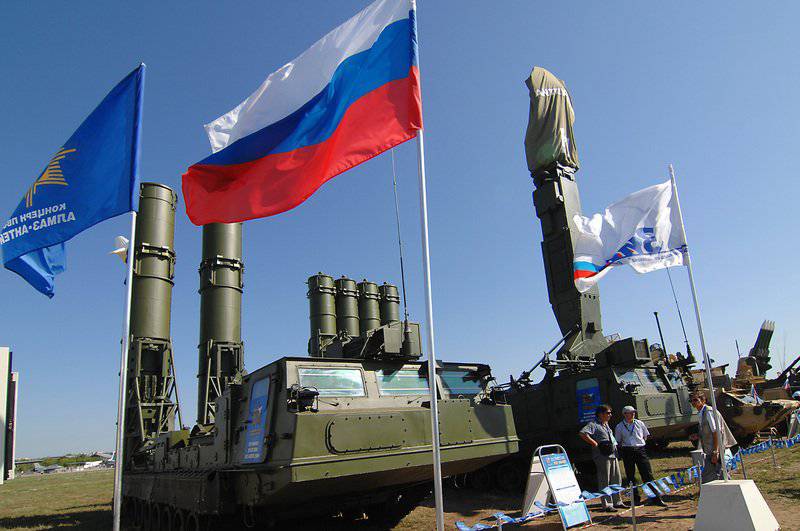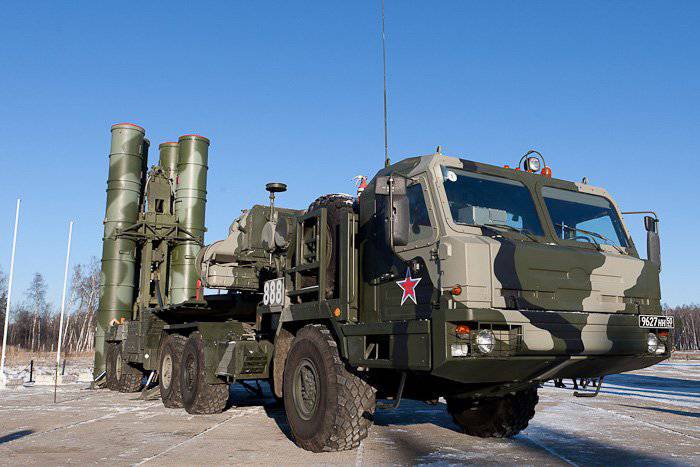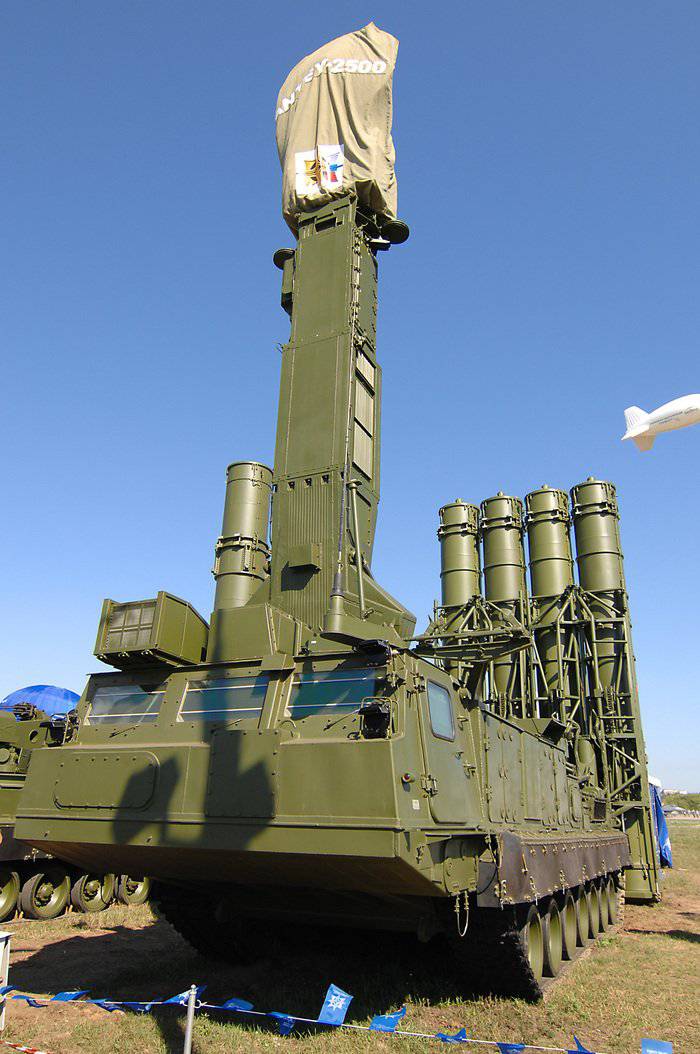Make a missile defense system of air defense: "Triumph" against "Anthea-2500"
It is a well-known fact that during the first years of its existence it was planned to deliver strategic nuclear weapons with the help of aircraft of the appropriate range and payload. However, the rapid development of anti-aircraft missiles and fighter aircraft soon demanded that the superpowers focus on strategic missiles. Due to the ballistic flight trajectory, they would have been much more efficient, and besides, the destruction of such a delivery vehicle in the 60-x or 70-x was an impossible task. Nevertheless, not all combat missions can be solved with the help of long-range ballistic missiles. This led to the emergence of medium-range and short-range ballistic missiles. With the appropriate guidance system, they allowed without special risk for the launcher and its calculation to attack targets at tactical or operational depth.
As for airplanes, for obvious reasons, over time, front-line aviation has become the main focus of their development. In the light of the goals that it is intended to fulfill, almost any innovation has proven to be useful. In particular, the wide distribution of high-precision weapons allowed to significantly increase the effectiveness of air strikes and reduce aviation losses. Thus, during the “Storm in the Desert”, guided weapons were used by the US Air Force in less than 10% of sorties, and in the Yugoslav war almost all the missiles and bombs used were “smart”. It is difficult to overestimate the effect of this - in the Persian Gulf the Americans missed two dozen planes, and the losses in Yugoslavia can be counted on the fingers of one hand. However, guided precision weapons cost more than usual, which, however, is offset by the high price of the aircraft itself.
But back to the means of air defense. The main feature of high-precision aviation weapons lies in the fact that it can be used from a long distance. Due to this, the entrance of the aircraft into the zone of enemy air defense becomes unnecessary, which reduces the risk of its loss. Thus, an effective air defense system capable of shooting down targets at distances exceeding the launch range of an enemy guided missile is required to effectively counter the armed forces, which emphasizes accurate air strikes. However, not all countries use a similar method of warfare. Many states have chosen to make accurate strikes at tactical and operational depth with the duty of ballistic missiles of medium and short range. Accordingly, to combat such a threat, the air defense system must be able to shoot down ballistic targets as well. Thus, the "ideal" anti-aircraft missile system is obliged to work on all types of targets that may arise over the battlefield.

It should be noted that for Russia the presence of such equipment is particularly important, because the attacks of a potential enemy using aviation or medium-range missiles are possible from almost all directions. The main reason is the specificity of the Soviet-American Treaty on the Elimination of Intermediate-Range and Shorter-Range Missiles. Only the missiles of this class already available in the USSR and the USA were destroyed, which did not prevent some countries that did not sign the treaty from continuing to create them. And with some of these countries, unfortunately, Russia has a common border - this is Iran, China and the DPRK. The relations of our country with the named states cannot be called strained, but you shouldn’t relax, having such “surprises” at your side. Therefore, it turns out that the territory of Russia must cover the air defense system, capable of acting on aerodynamic and ballistic targets.
The main snag in the creation of such air defense missile systems lies in the various parameters of the flight target. Aerodynamic goal has a relatively small speed, and its trajectory almost always lies in the horizontal plane. In turn, the warhead of a ballistic missile always falls on the target at supersonic speeds, and the angle of this fall is in the range from 30 ° to 80 °. Accordingly, the speed of the warhead is constantly increasing, which significantly reduces the time for response. Finally, the missile warhead is small and has an equally small effective reflective surface, which also makes it difficult to detect. And this is not counting the possibility of separating the warhead, the use of air defense / missile defense weapons, and so on. Taken together, this is the main reason that only developed countries can create a combined air defense and missile defense system, and such work takes a lot of time from them.
So, the United States took almost 13 years to create the Patriot air defense system. All this time, American developers have been doing their utmost to simplify the electronics of the rocket and ensure the effectiveness of work on modern and long-term goals. However, all efforts to universalize the anti-aircraft missile system did not yield the expected result. As a result, it turned out that the Patriot is only able to shoot down every third Scud missile. In addition, no interception occurred at a distance over 13-15 kilometers from the launcher. And this is taking into account the fact that the missile that was being shot down was significantly older than the one that was shot down. Subsequently, the Americans carried out several upgrades to the Patriot air defense system, but it was not possible to achieve a significant increase in the effectiveness of hitting ballistic targets. In particular, and therefore, interceptor missiles for strategic US missile defense were not made on the basis of available technology.

In the Soviet Union, too, paid attention to universalization, but did not do it the same way as the Americans did. After conducting initial surveys on the C-300 air defense system, it was decided to make “P” and “B” lines as a means of air defense, and to add to the defeat of ballistic targets only if there is an appropriate opportunity. These possibilities, as the future showed, were not so many. The composition of the equipment of the complexes changed, new missiles were added, but a significant improvement in the sphere of hitting ballistic targets was not achieved. Sometimes you hear that the newly created C-400 air defense system, contrary to the statements of the developers, cannot be used for tactical missile defense, because it maintains its “pedigree” from the C-300П complex. And he, as already mentioned, normally works solely for aerodynamic purposes. In the same way, the C-500 complex, which is currently being developed, is also criticized in advance. Given the secrecy of information on these two systems, such statements can be considered premature, if not untrue. Nevertheless, it is not that easy to cross the air and tactical antimissile defense, and there are fewer details about the work of the Almaz-Antey concern than we would like.
There is also an opinion that the C-300В line should be taken as the basis for new complexes. In favor of this opinion, the peculiarities of its creation are given - as part of its armament, there are 9М82 missiles, originally adapted for ballistic attacks. However, the missiles, which 9М82 was created to combat, have long been decommissioned, and the ability of the interceptor missile to hit more modern means of attack is questionable. Nevertheless, the C-300B continue to serve as the best basis for promising anti-aircraft missile systems. You can agree or disagree with this opinion. But only as long as the dispute goes on in a normal way. But sometimes some people who have a certain relationship to the creation of domestic air defense and missile defense, allow for rather dubious statements. For example, that “managers from the Ministry of Defense” simply do not understand the difference between C-300P and C-300В, which is why they are ruining a promising branch of the development of air defense systems. Finally, a few weeks ago, a notorious journalist on the air of a notorious radio station accused C-400 of not bringing. The logic of the charges was “beyond praise”: now, they say, long-range missiles are being tested, and only full-time weapons are in service. Therefore, the complex is bad, as well as the state of affairs in the Almaz-Antey concern. Extrapolation of this conclusion to the entire national defense industry, however, was not.
And yet you should pay attention to the later models of the air defense missile system from the line with the letter "B", for example, on the C-300ВМ. This complex is sometimes also referred to as "Antey-2500". The word "Antey" denotes the head developer, and the number 2500 is the maximum speed of a ballistic missile that C-300BM can shoot down. The main advantage of “Anthea-2500”, to which supporters of the priority of the C-300В line appeal, is its system of detection and targeting. As part of the electronic equipment C-300BM there are two radars: one circular view and one program review. The first tracks the entire surrounding space and is primarily intended for detecting aerodynamic targets, and the second “inspects” the sector at 90 ° horizontally (elevation angle to 50 °) and detects ballistic targets. The radar program review of the C-300BM air defense missile system can simultaneously lead to 16 targets. It is noteworthy that, to date, no country in the army has such systems. In particular, that is why, in its time, the United States had to fight enemy missiles in a complex pattern. Recall that the launch was detected from the early warning radar of a missile attack in Turkey; then the information was sent to the Norad command center in the USA, where the received data was processed and target designation information was generated, and only after that the necessary data was sent to a specific anti-aircraft complex. Antey-2500 can do all this on its own, without resorting to "third-party" systems.
Armament C-300ВМ consists of two types of missiles:
- 9М82М. Able to accelerate to 2300-2400 m / s and attack ballistic targets. The maximum target speed at which it is ensured its defeat exceeds four and a half kilometers per second. In addition to the ballistic targets, the 9М82М can also work on aerodynamic ones, in which case the maximum damage range reaches two hundred kilometers;
- 9М83М. Flight speed up to 1700 m / s, designed to destroy aerodynamic purposes. According to the characteristics, it differs little from the previous missiles of the C-300В family of systems.

Rockets are the most unified and have a two-stage design. Engines solid rocket. It is interesting that the combat part of the missiles, when undermined, scatter the finished fragments not evenly in all directions, but only in a relatively small sector. Combined with good pointing accuracy, this increases the likelihood of reliably destroying all types of targets. According to the available information, the Antey-2500 missiles have a combined guidance system: the missile is set at a given ground equipment using an inertial system, and a semi-active radar guidance system is activated at the final flight segment. Direct control is carried out using gas-dynamic control surfaces. The fact is that the most effective defeat of a ballistic target occurs at those heights where the "traditional" aerodynamic control surfaces almost completely lose their performance. Gas-dynamic steering wheels are also installed on the US SM-3 antimissiles, capable of working on targets in the trans-atmospheric space.
Despite all the advantages of the “Anthea-2500”, it is not entirely clear why it is he who is proposed to equip the country's air and missile defense. This complex belongs to the line “B” of the C-300 family. As is known, the letter “B” in the title of the system was originally decoded as “military”. In turn, the line "P" was made to equip the air defense forces. Thus, the use of C-300B (M), where C-300P and its “descendants” should operate, is not a completely logical step, including without taking into account the advantages of individual systems. However, nothing prevents you from using the C-400 or C-500 developments in the future, which were obtained while creating the same “Antea-2500”. Interestingly, C-300ВМ is actually already an outdated system. It will be replaced by C-300B4 and there is not much time left to wait for this. Two weeks ago, the military and the Almaz-Antey concern signed a contract for the supply of V4 modification complexes. The first complexes will be delivered to the troops by the end of 2012. C-300B4 has approximately the same characteristics as C-300BM. According to the available information, the difference in some indicators is due to the possibility of retrofitting old C-300В to the state C-300В4.
To stop disputes regarding the feasibility of adopting the C-400 complex (previously called C-300PM3), the new missile 40Н6Е should. Ammunition with a maximum range and height of 400 and 185 kilometers, respectively, in the future will be able to clearly demonstrate "who is the owner of the house." But, unfortunately, the creation of 40H6E was significantly delayed, which did not fail to use various persons in their “revelations”. Tests of the new rocket will be completed this year and after that it will be put into service. Thanks to 40H6, the C-400 "Triumph" complex will finally be able to cover the country not only from aerodynamic, but also from ballistic targets. Hopefully, after the launch of the new missile, disputes about the fate of our anti-aircraft and missile defense will not concern the minuses of the existing systems, but the development of new ones. But the new C-500 SAMs are promised to be done in five years.

Information